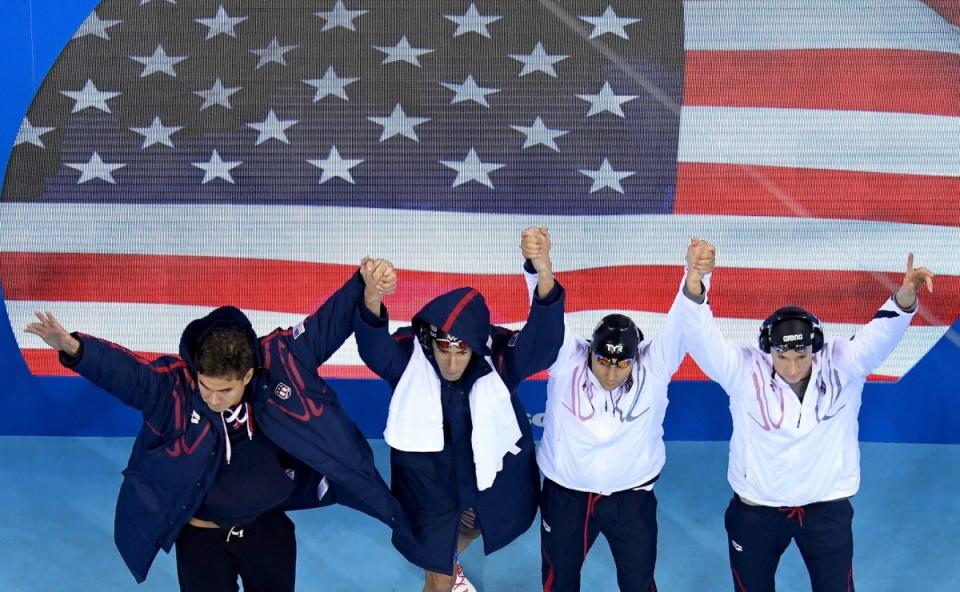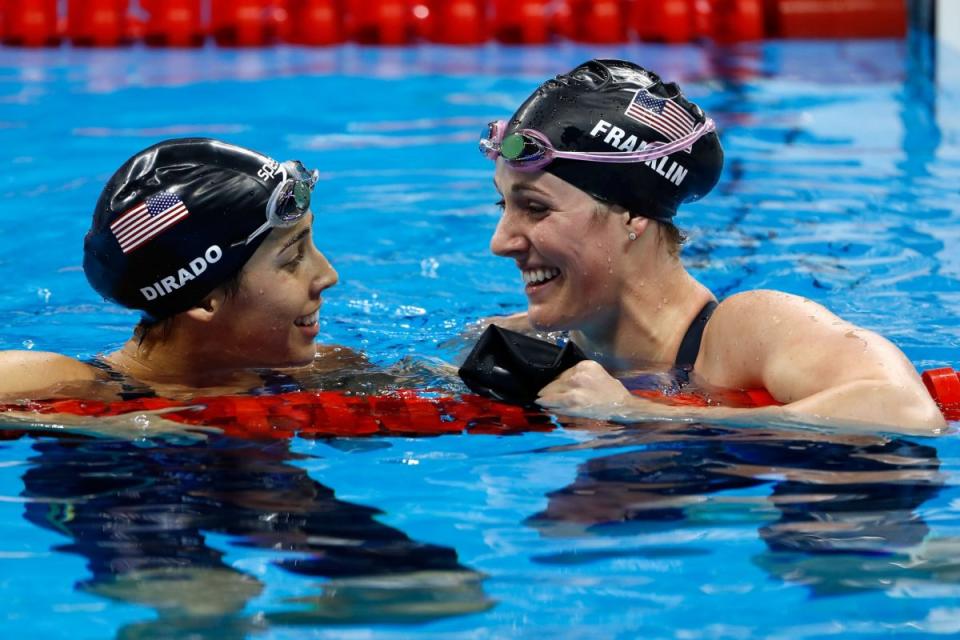How a uniquely American motivational technique helped USA Swimming dominate in Rio
Medal count | Olympic schedule | Olympic news
RIO DE JANEIRO – The Homestead Act of 1862, while undoubtedly significant legislation in American history, wouldn’t seem terribly apropos to 21st century Olympic swimming.
I mean, not even old man Michael Phelps was swimming in 1862. But still, through the fertile motivational mind of U.S. Olympic assistant coach Greg Meehan, the Homestead Act was invoked in Rio.
[Pat Forde: Why it’s time for Michael Phelps to call it a career]
There was Team USA one day in a meeting room in the Athletes’ Village, getting the background story on the land-grab tactic of “staking your claim.” And then there were Team USA swimmers being handed an American flag on a stick with a note attached for each event of the Olympic competition – the 200 backstroke, for instance, and the 100 breastroke, and the 400 freestyle.
And then there were the swimmers in each of those events going outside and making like homesteaders.
They planted those flags, with their attached notes, in the Brazilian grass. They staked their claim to ownership of those specific competitions, as it were.
In addition to the discount history lesson, this was one of the many team-building techniques the U.S. coaching staff concocted during what you could call “The Month That Made America Great Again.”
It was a hell of a month. Between July 4th and August 5th, the United States swim team morphed from questionable to powerful.
[Related: Twitter celebrates Michael Phelps’ incredible Olympic career]
The first date is the day after the Olympic Trials ended in Omaha, and the second date is the day before the swimming competition started here. In that space, a year’s worth of fears were destroyed and replaced by the old quadrennial confidence. A group of swimmers who spend most of the year competing with each other came together like best friends.
The result was one of the most well-rounded, high-achieving, world-beating Olympic swim teams ever assembled.

The final American medal tally in the pool was 33 – most since the same number was recorded in Sydney in 2000. The gold-medal total was 16, same as 2012 in London. The rest of the world won 17 golds combined. There were just three events – men’s 400 freestyle, women’s 200 breastroke and 200 butterfly – where no Americans graced the podium.
Last time the U.S. exceeded those numbers in both gold medals and total medals? Try 1984, when the Eastern Bloc nations boycotted the Los Angeles Olympics and created an American mismatch.
Now consider this: the haul was produced without 2012 stars Missy Franklin or Ryan Lochte earning a single individual medal.
[Photos: Michael Phelps with all of his Olympic medals]
This was a big showing – a testament to endless depth and new heroes. And that big showing wasn’t much expected last year when the U.S. performed poorly at the World Championships in Kazan, Russia. Nor was it widely predicted after the Trials, when many American times were pretty unspectacular in comparison with the 2016 world leaders.
Men’s head coach Bob Bowman made mention Saturday night of the occasional dire predictions for America in Rio. He took some glee in pointing out how wrong those predictions were.
“Somehow,” Bowman said, “we found a way to do it.”
The way included a couple of signposts on the trek back to the top of the sports world.
The first one: Olympic Trials are less of an indicator of future performance than they are simply a way to thin the herd of contenders. Times should be viewed with caution, because the pressure of the event creates an artificial slowness.
[Related: Michael Phelps caps legendary Olympic career with relay gold in final race]
“Trials is such a pressure cooker that it puts a completely different type of stress on swimmers,” said Frank Busch, the U.S. national team director. “Here, the team becomes a unit. The unit starts when Trials finish.”
He described an alliterative, three-part process of developing chemistry: preparation, performance and pride.
The preparation work with this team was done during the original stage of camp, in San Antonio. When the team moved from there to Atlanta, the focus shifted more to performance – training to hit specific pace numbers and sharpen racing capabilities. And from Rio came the pride element – which at one point included the entire team walking out into the Athletes’ Village and loudly singing “God Bless America.”
Busch was not shy about invoking a little nationalism. He brought up the presidential race, and not in glowing terms.
“I talked about how toxic and how divisive that thing is right now,” Busch related. “The American people want something positive, something that unifies our country. It’s the Olympics. They can’t wait to watch our guys.”
The guys, and women, showed up. They were ready. Freed from the trauma of Trials, they performed.

My medal predictions were ambitious: 34 total, and 13 gold (http://yhoo.it/2aO8hq4). The Americans met those expectations, aided in large part by a second consecutive shrinking Olympic performance by Australia, the perennial chief rival of the United States.
As usual, America got several stellar performances from a few Olympic first-timers: Ryan Murphy, Josh Prenot and Townley Haas for the men; Lilly King, Simone Manuel and Kathleen Baker for the women.
And of course there was Katie Ledecky at the height of her powers (four gold medals, one silver), and one last command performance by Phelps (five golds, one silver). They combined to play firestarter for the Americans on the second night of the swimming competition – Ledecky breaking the world record in the 400 freestyle and Phelps swimming a scorching leg of the winning 400 free relay.
Momentum flowed from there. The men’s team turned out to not be too old after all, and the women’s team overcame the puzzling downturn of Franklin.
Not to be overlooked as a factor in the American success: the U.S. coaches basically made every correct call with relay lineups. Not all of them were easy calls, but they all worked out about as well as could possibly be expected. When the relay tally is five gold and one silver, they had the right people swimming at the right times.
There’s no word whether the American homesteaders’ flags are still planted in the Athletes’ Village. But the U.S. staked its claim to swimming dominance in Rio, and brought home enough hardware to prove ownership.


